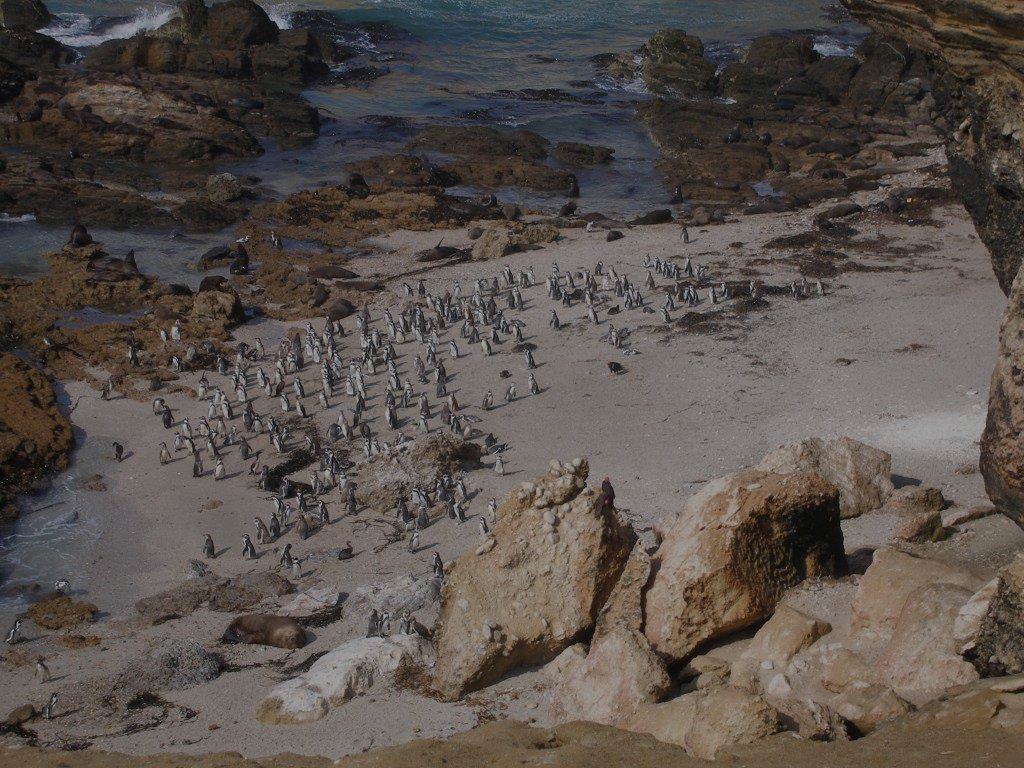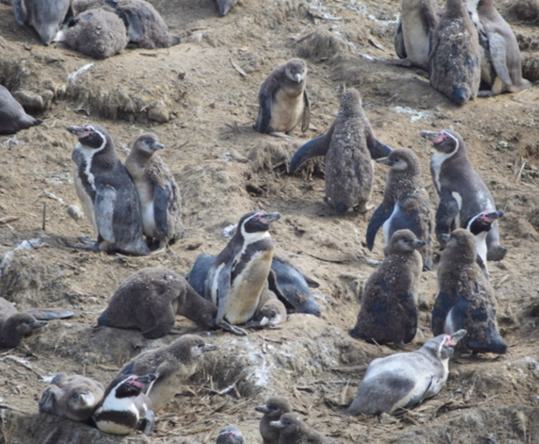
Center for Conservation in Punta San Juan, Peru

Background
The Humboldt penguin is found only along the rugged Pacific coast of Peru and Chile. Although most people think of penguins as cold weather birds, most live in temperate or even tropical habitats, and many Humboldt penguins live and breed where one of the earth’s driest deserts meets one of the coldest ocean currents in Punta San Juan, Peru. Approximately half the entire Peruvian Humboldt penguin population calls Punta San Juan home. There, the continental shelf comes very close to the coast line creating an upwelling of cold nutrient rich water—conditions that provide a fertile environment for the Anchoveta, the primary food source of the penguin and many other sea birds and marine mammals. The presence of large numbers of sea birds has produced some of the most fertile guano fields in the world. Guano, the excrement of these birds, provides a soft substrate the penguins can use to dig their nesting burrows.
Drastic Habitat Disruption
The Humboldt penguin faces an uncertain future brought about by emerging threats that imperil the very existence of the entire species in the wild. These include the harvest of guano for use as an organic fertilizer, underwater natural gas pipelines that emit toxic seepage into the water, recurring El Nino Southern Oscillations and vulnerability to predators. Disruption of the fragile ecological balance of Humboldt penguins’ region is another large threat to the species. Peru’s largely unregulated fishing industry not only removes the Humboldts’ food supply, but also places them at risk of entanglement in fishing nets. The Humboldt penguin population has declined significantly in the past 20 to 30 years. Today the Humboldt penguin is listed as threatened by the Red List of the IUCN.
St. Louis Interest

The Saint Louis Zoo has been home to Humboldt penguins since 1977. In 2003 the Penguin & Puffin Coast opened and provided a new home for our Humboldt penguins. Our penguins are part a North American population that is genetically and demographically managed by the Humboldt penguin Species Survival Plan. Through this plan, the Saint Louis Zoo has worked closely with many other zoos to ensure the breeding of a healthy and genetically diverse captive population of Humboldt penguins.
In recent years, the Population and Habitat Viability Assessment recommended a comprehensive census of the Humboldt penguins of Peru and Chile as the first significant step toward the recovery of the species. Staff members participated in the biannual census of the entire Peruvian Humboldt penguin population in 2004, the same year that the Saint Louis Zoo, Brookfield Zoo, Philadelphia Zoo and the Center for Resource Sustainability (a Peruvian NGO) entered into a memorandum of understanding aimed at securing the future of Punta San Juan. This milestone marked the first formal declaration of protection of marine waters in Peru resulting in the inclusion of Punta San Juan, along with 33 other “guano” islands and peninsulas, in Peru’s protected areas system in 2009.
Since 2007, the Saint Louis Zoo has conducted this census of the entire Peruvian coast every year. This census now shows that the total combined population in Peru, and along the cost of Chile, can be reliably estimated at only 40,000 Humboldt penguins — a tiny percentage of the population first discovered in the 19th century along the same coastline.
In addition to the census, the first sustainable harvest of guano was conducted at Punta San Juan in 2001. Former Curator of Birds Michael Macek (now Zoo Director) participated as an international observer at that harvest, which demonstrated that the valuable Peruvian resource could be collected without negatively affecting the threatened Humboldt penguin or the diverse variety of marine species that call Punta San Juan home. In 2012, the Center participated in a third sustainable guano harvest.
Goal
To facilitate the designation of Punta San Juan as a Marine Reserve under the Peruvian Protected Areas System and secure the future of the Humboldt penguin in Punta San Juan.
Conservation Science
The center strives to secure the funding necessary to maintain adequate personnel to continue the collection of biological data and protect Punta San Juan. Support also is provided to improve Peruvian fisheries management and increase awareness of marine conservation issues. This center has helped to create an opportunity for real change. By forging a bond between the staffs of North American zoos, Peruvian partners, government and non-governmental organizations, the center has taken the first steps in forming a true conservation coalition.
Partners
The Brookfield Zoo
The Philadelphia Zoo
AZA Humboldt Penguin SSP
AZA Penguin Taxon Advisory Group
Colchester Zoo, Britain
Woodland Park Zoo
Sedgwick County Zoo
Centro Para La Sostenibilidad Ambiental
Harewood Bird Garden, Britain
Acquario di Cattolica, Italy
Alteris, Netherlands
Moody Gardens
Tom Leiden

